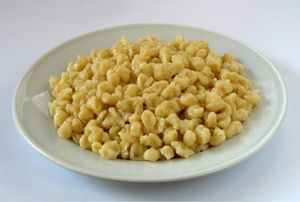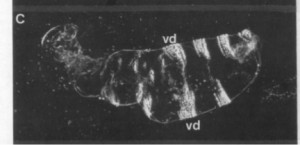by Juliane
This week I will write about Drosophila genetics. The founding fathers of modern genetics were very creative when naming their favorite genes; from Sonic Hedgehog to Bride of Sevenless, their gene names read like titles of novels rather than hard science. While being super-creative however, they did groundbreaking science, resulting in several Nobel prizes.
This is a plate of spätzle.
It’s the German version of macaroni and cheese, which has to be made from scratch every single time.
Here I zoomed in onto a single one.
And underneath the close up is a picture of a Drosophila embryo missing the gene spätzle. Can you see the similarity?
spätzle is the ligand for Toll; a receptor which is absolutely necessary to establish the dorso-ventral axis in developing embryos (not only in flies). After maternal cells surrounding the embryo have established an environment suitable for development, the protease easter cleaves spätzle and the resulting cleaved form binds the receptor Toll, which in turn relocates the transcription factor dorsal into the nucleus, where it activates all of the appropriate genes for proper dorso-ventral patterning. In adult flies the Toll pathway is involved in innate immunity, and homologues of Toll are found in almost all animals. Of course spätzle acts as a ligand. All this writing about spätzle made me hungry, so I am going to cook now.
References:
David Stein & Christiane Nüsslein-Volhard (1992) Multiple extracellular activities in Drosophila egg perivitelline fluid are required for establishment of embryonic dorsal-ventral polarity, Cell Volume 68, Issue 3, Pages 429–440
Kathryn Anderson & Christiane Nüsslein-Volhard (1984) Information for the dorsal–ventral pattern of the Drosophila embryo is stored as maternal mRNA Nature 311, Pages 223 – 227
Weber, A.N. et al (2003) Binding of the Drosophila cytokine Spätzle to Toll is direct and establishes signaling. Nat. Immunol. Aug;4(8):Pages 794-800
Flybase at http://www.sdbonline.org/fly/torstoll/spatzle.htm
http://www.wikigenes.org/e/gene/e/43256.html



3 Comments
Yolanta Kovalko posted on October 21, 2013 at 10:00 am
I love this dish, we have a similar dish in Poland called kopytka made with flour and potato.
julianeh posted on October 21, 2013 at 3:38 pm
maybe a polish geneticist would have called the gene kopytka
Globelink posted on March 19, 2014 at 10:49 am
Who said that science is boring? It’s a lot of fun and creativity!
Well done!